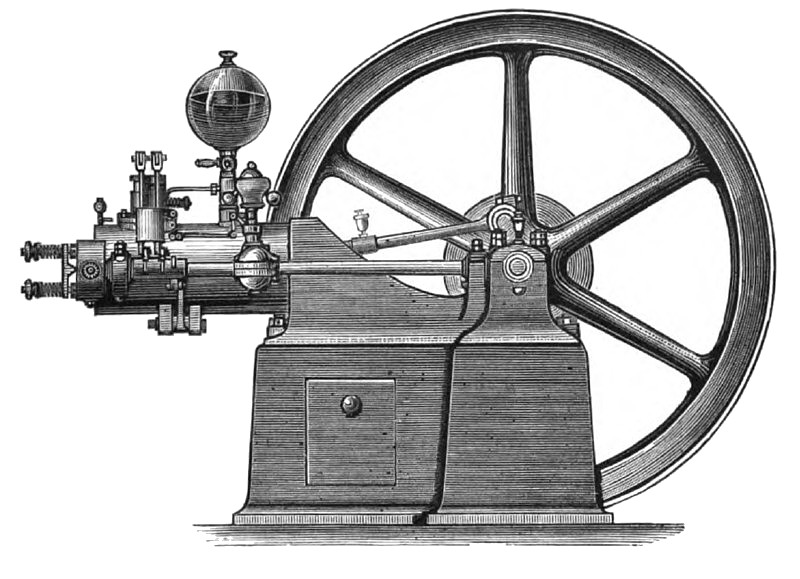|
Title: |
1886 Article-A. Shirlaw & Co., Spiel's Petroleum Engine |
|
Source: |
The Electrical Review, 12 Feb 1886, pg. 137 |
|
Insert Date: |
7/1/2014 1:25:58 PM |
SPIEL'S PETROLEUM ENGINE.
A very neat and successful form of petroleum engine, invented by Mr. Johannes Spiel, of Berlin, has lately been introduced into this country, and it is described in the current issue of Engineering. In its general appearance the engine, which we illustrate this week, very much resembles the well-known Otto motor, the points of difference relating mainly to the devices by which the motive fluid is measured and delivered to the cylinder, in admixture with the proper proportion of air. The cycle of operations is that with which the reports of the gas engine law cases have familiarized all the world; the piston on its out-stroke draws in a charge of air and petroleum; it then returns compressing this mixture, which is exploded as the crank passes the back centre. The next stroke sees the combustion and expansion of the charge, while the fourth and last stroke of the cycle drives out the products of combustion. There is thus one acting stroke in every four, the motion being continued through the other three by the energy stored in the flywheel.
The source of power is petroleum spirit, otherwise known as benzoline, and also as naptha. This has a specific gravity of 0.7 or 0.71, and a very low flashing point, so that it will not pass the Abel test; consequently it cannot be stored and used without special precautions. If the proper conditions are observed the use of this spirit does not involve any extraordinary risk, for it is employed in large quantities in the dry cleaning process, and also in the manufacture of India rubber. When used with this engine it is stored in a closed receptacle connected by a pipe and hand pump to the reservoir. From this reservoir there runs a pipe to a pump, by which measured quantities are injected into the cylinder.
The firing light is the flame of a lamp, which is kept constantly burning. At a suitable moment it ignites the burner in the valve, and by the quick return movement, a flash is transported to the firing apparatus in the cylinder. The combustible mixture finds its way into the burner during the compression stroke. In front, and surrounding the burner, is a chamber which serves to convey a flame from the outer jet to the charge in the cylinder. The chamber forms an annular space round the burner, and a passage opens into this space, and maintains a communication for the supply of the combustible gas or vapour during the times when the main passage is closed. The gas passing through flows round the burner, and thus becomes heated and ignites more readily. When the chamber is filled with gas it is ignited by the outer flame, and continues to burn during the return stroke of the firing valve until the chamber comes opposite the main passage, when the charge in the combustion chamber of the cylinder is ignited. The maintenance of the firing flame is effected by the flow of gas through the passage.
The engine at present in this country will work up to 3½ brake horse-power, with a consumption of about
one quart of benzoline per horse-power per hour; the same rate of consumption is also obtained if the power be reduced to 2 horse-power. At the rate of 8d. per gallon, this represents an expenditure of 2d. per brake horse-power per hour. The motor works very satisfactorily, does not clog in the valves or cylinders, and bids fair to find a good field where gas is unattainable and the local rules concerning the storage and transport for petroleum spirit are not too stringent.
The engine is being introduced in this country by Messrs. Crozier & Co. |
|
 1886 A. Shirlaw & Co., Spiel's Petroleum Engine
1886 A. Shirlaw & Co., Spiel's Petroleum Engine
|
|